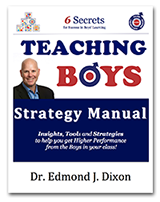CHALLENGE (1)
Why does Challenge Help You’re the Boys in Your Class to Learn?
Mountain climber George Mallory became famous in the 1920s with his response to a reporter’s question, “Why do you want to climb Mount Everest?” He retorted, “Because it is there.” In that response he spoke for countless males throughout history who have explored new frontiers, launched enterprises in the face of extreme odds, and engaged in death-defying feats. Because boys release testosterone when they set goals and achieve them they are always looking for ways to challenge themselves.
In the process Challenge becomes a learning tool with boys because they crave it and use it to discover things about themselves and their environment. I often talk about the “ring toss” experiment that was done with college-aged males and females. They had a simple task of getting rings on a post—with no other instruction given. The females simply did what they were asked and tossed the rings on the post. The males, on the other hand devised various ways to make it more challenging by tossing the rings from different distances, behind their backs and so forth. In the process, they were no doubt attempting different strategies using speed, spin, and height, with the goal of improving their performance. This unconscious drive for mastery is triggered naturally and without prompting when males decide to respond to a challenge.
Below is an easy way to start to use challenge in the classroom today:
SETTING A DAILY IN-CLASS CHALLENGE (Informal)
- Choose some work that students will be doing today (i.e. work from a math text book, research on a project, etc—any learning task that some specific time is set aside for will do)
- Once they know what to do, but before they begin write the word “Challenge” on the board.
- Ask them to come up with a little challenge for themselves related to the work (i.e. getting so many questions done within a timeframe, finding 3 primary sources, etc.). It should be something they can accomplish within the given timeframe and something the THEY choose. Simple is best!
- Have them write it down somewhere privately.
- Once the timeframe is up, ask for volunteers to share their challenge and whether they succeeded at it.
TRY IT AND LEAVE A COMMENT…
Did you find some of your students (particularly boys) more focused during the work period?
Were they willing to share their challenge after? How did they do?





